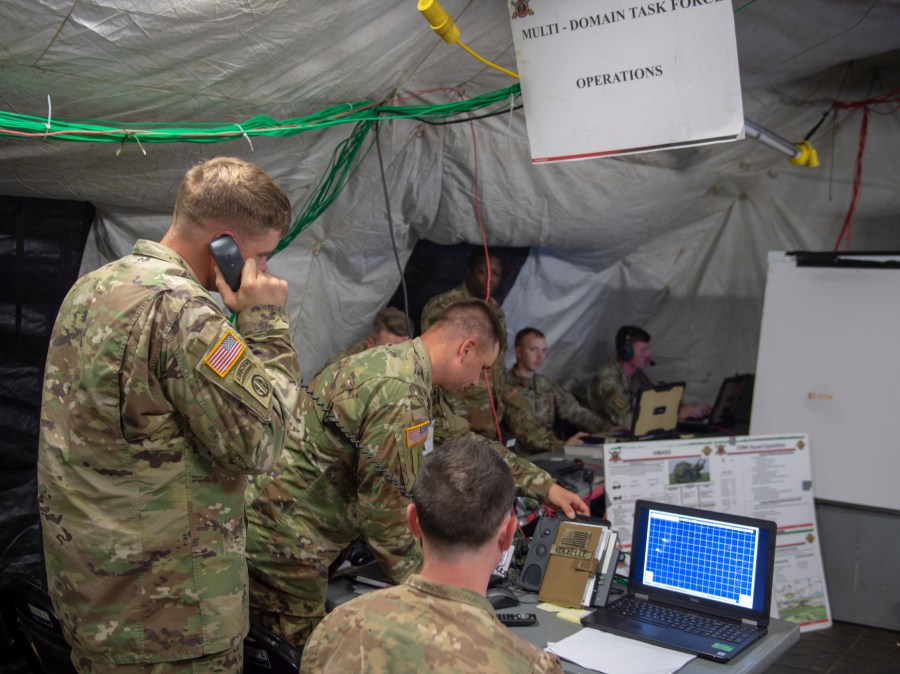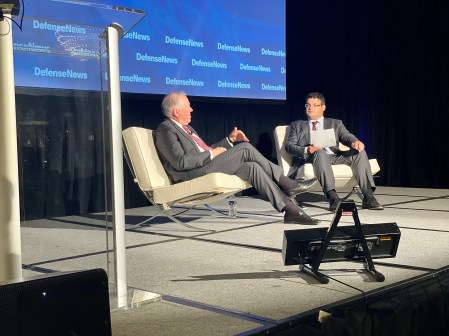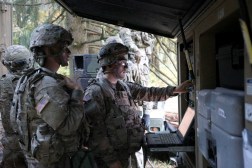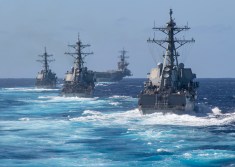Army prioritizing data as it revamps for large-scale ops at the division level

As the Army is honing in on large-scale operations, shifting its main unit of action from brigade to division, and aligning its priorities with joint efforts to connect sensors and shooters, leaders believe data will be the key driver.
The service’s next capability build as it incrementally modernizes its network will be focused on data and connectivity needs at the division level and other supporting elements.
The Army has adopted a multiyear strategy involving the incremental development and delivery of new capabilities to its integrated tactical network, involving a combination of program-of-record systems and commercial off-the-shelf tools. Those “capability sets” now provide technologies to units every two years, each building upon the previous delivery.
In between these deliveries, the Army has hosted several technical exchange meetings to gather members of industry, the Army acquisition community, Army Futures Command and the operational community to outline priorities and capabilities to modernize the service’s tactical network.
The most recent, in Philadelphia, was the first to focus on division of action and capabilities needed to support that.
“That future battlefield means that we’re going to have to truly take advantage of data at a scale and at a speed” that the service isn’t used to, Raj Iyer, the Army’s chief information officer, said at the meeting May 9. “It also means that our fight, God forbid, in a large-scale combat operation, is going to be at the division or the corps level, not at the brigade combat team level … That’s a big change for the Army.”
The service says it’s moving from a network-centric approach to a data-centric approach, which prioritizes the flow of information globally.
For Army leaders, the first step is allowing data to flow more freely.
“The first thing we have to do is learn how we can get complexity off the transport and allow data to move freely through it,” Brig. Gen. Jeth Rey, director of the Army’s network cross-functional team, said at the conference.
But this problem also requires the Army to determine what data and how much of it resides at what echelon, which the Army is experimenting with.
In order to really achieve the data-centric model, as well as the Pentagon’s Joint All-Domain Command and Control (JADC2) concept for better connecting sensors and shooters, a true data fabric will be essential.
“In order to achieve data centricity, we have to have those cloud and systems around the world,” Rey said. “I believe in order to achieve JADC2 and sensor to shooter, a data fabric is going to be required.”
A data fabric is not a single solution, but rather, a federated environment that allows information-sharing among various forces and echelons.
This vision was solidified for Rey at a Project Convergence experiment last year. Project Convergence is an annual Army experiment that tests technologies and concepts associated with the Pentagon’s JADC2 effort.
“Coming out of PC ’21 is where we really saw the requirement for a data fabric,” Rey told reporters on the sidelines of the conference. “You’ve heard us talk sensor to shooter, sensor to shooter, but the only thing that really allowed us to pull those sensors in and make sense of the sensor information was by having a data fabric. That’s why we really focus this to this [technical exchange meeting] on data, because that’s where we needed to talk.”
Rey called a data fabric the “underpinning” of what’s needed to visualize what’s happening on the battlefield with sensors.
This will be critical to achieving not only JADC2 goals, but also realizing what some officials call the “kill chain of the future.”
Next year’s Project Convergence will bring coalition partners into the fold for the first time. Military officials always stress that the U.S. does not fight alone and thus, and it needs to be able to pass data back and forth to coalition partners so the optimal asset can take action.
“It’s not only just data, we’re talking about sensor data off of our mission systems to ensure we can share it not only with our joint partners, but also share it with our coalition partners,” Rey said. “Can they tie into our Patriot missiles and then share the data and then the best system shoot? That’s what we’re going to try to find out about the integration piece of data.”
Officials said they want the best assets in the best areas to be able to take action.
That means leveraging “the right sensor through the right command-and-control node, getting to the right shooter, to be able to facilitate that kill chain and you’re getting information to decision-makers,” Maj. Gen. Robert Collins, program executive officer for command, control, communications-tactical, told reporters.






